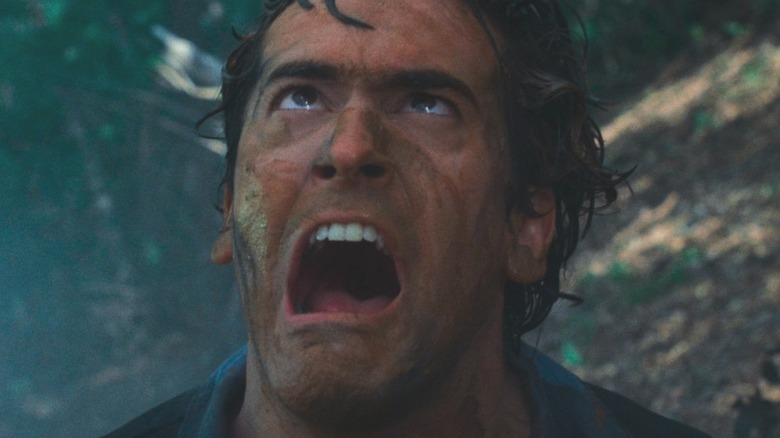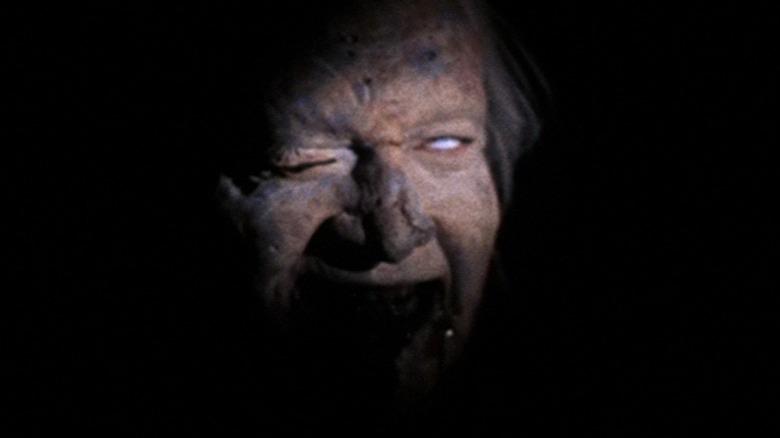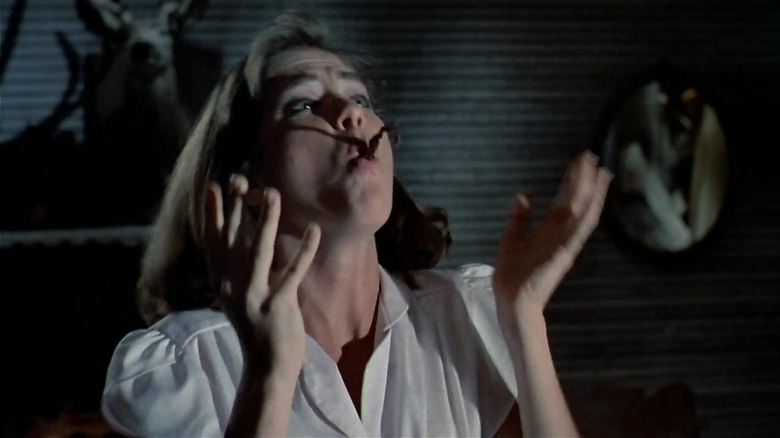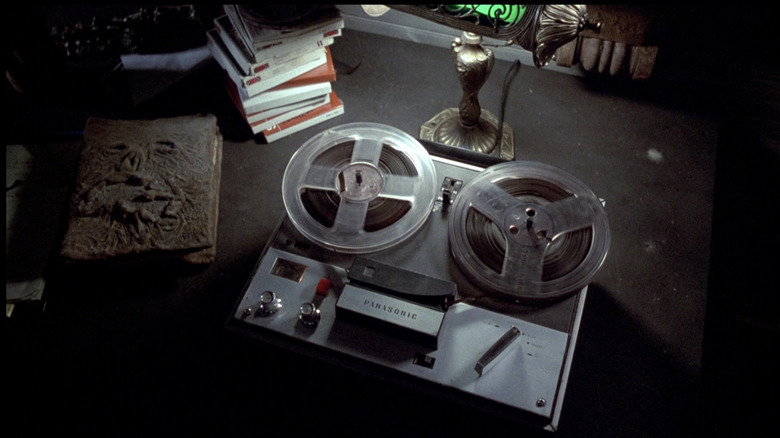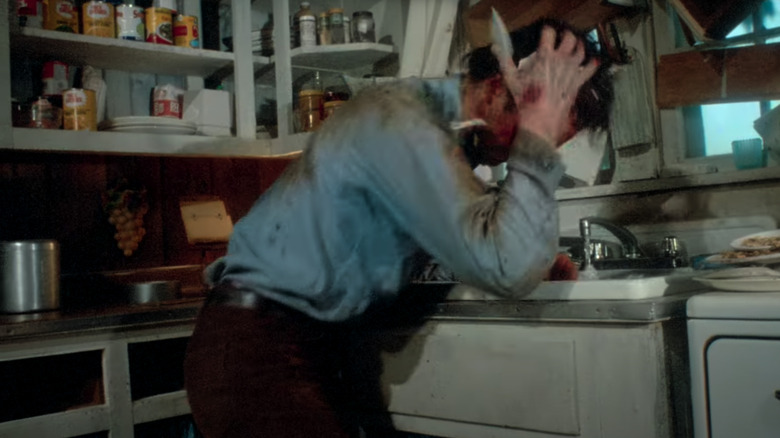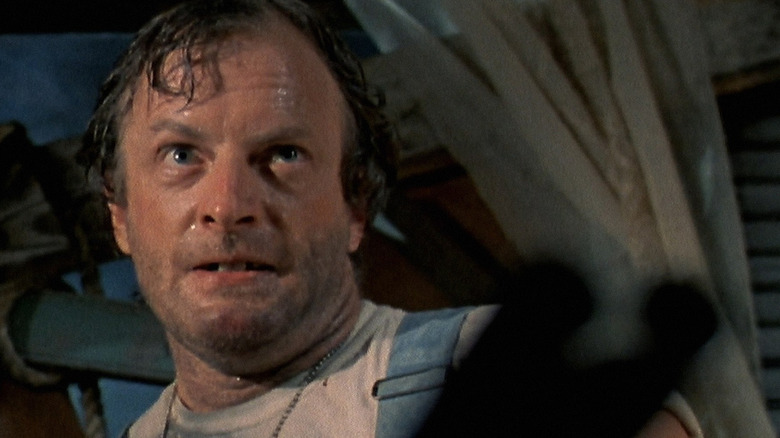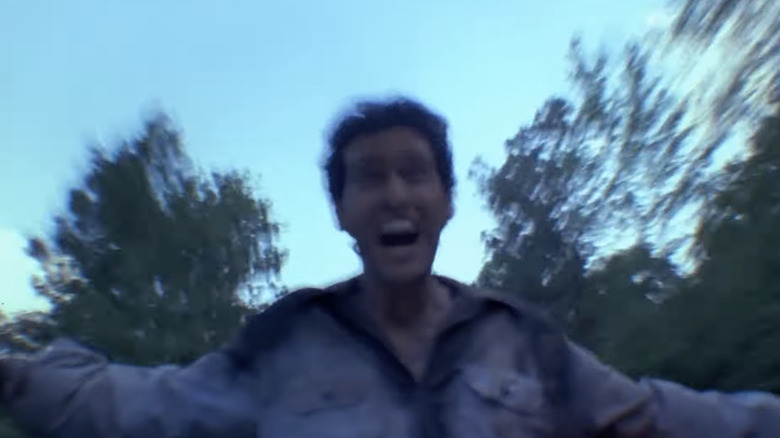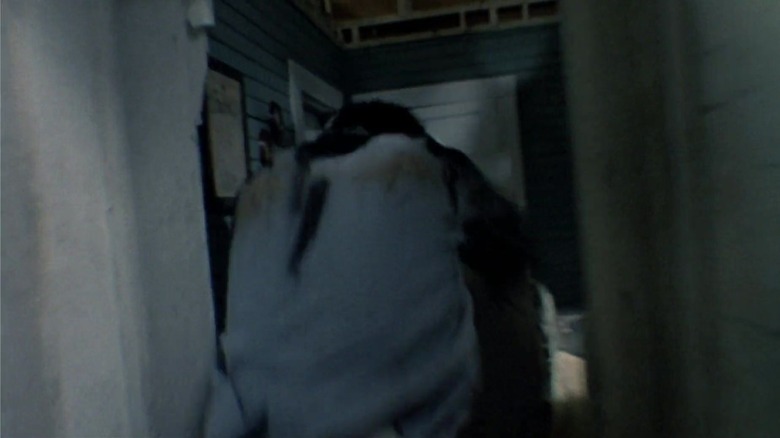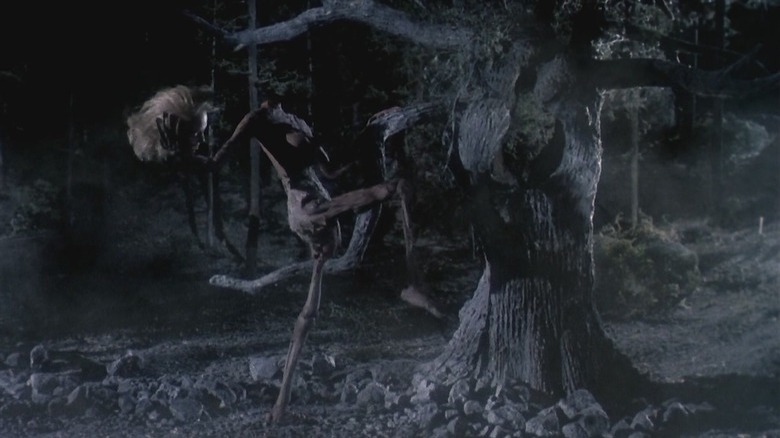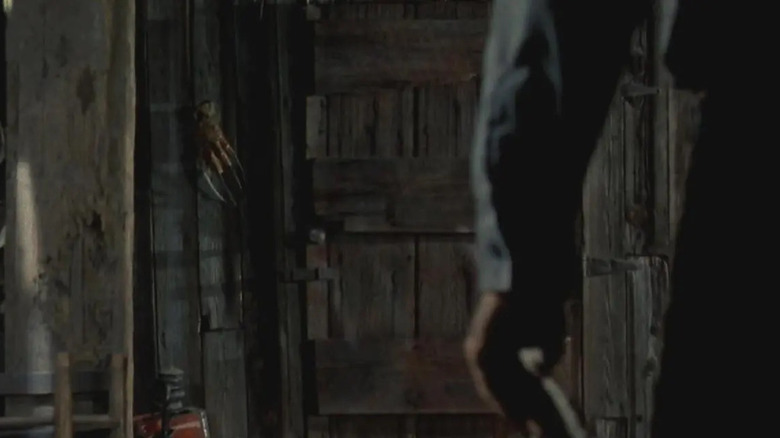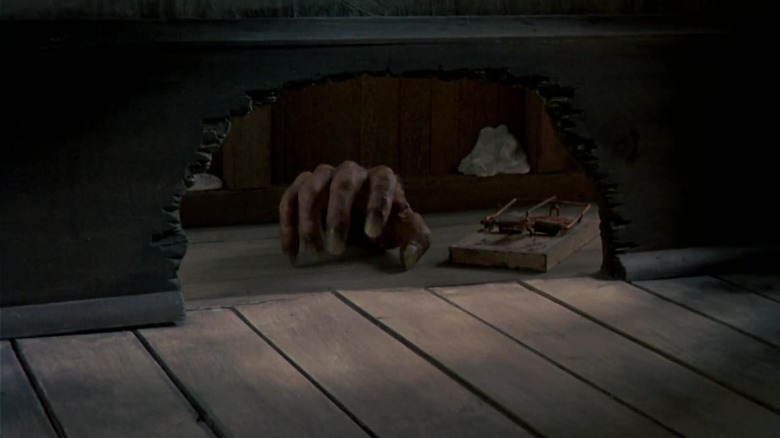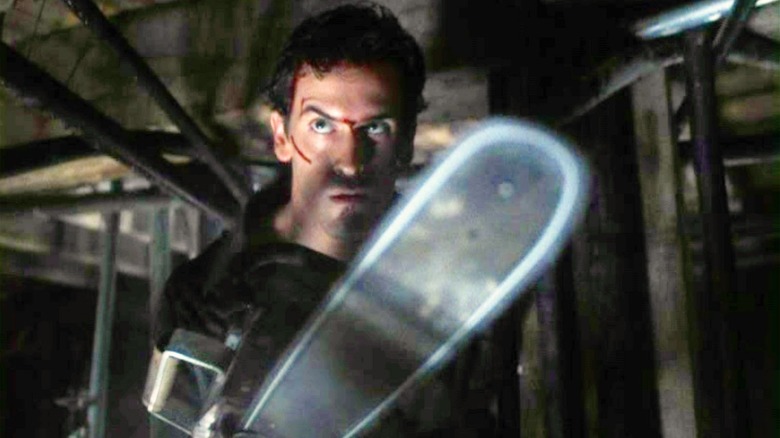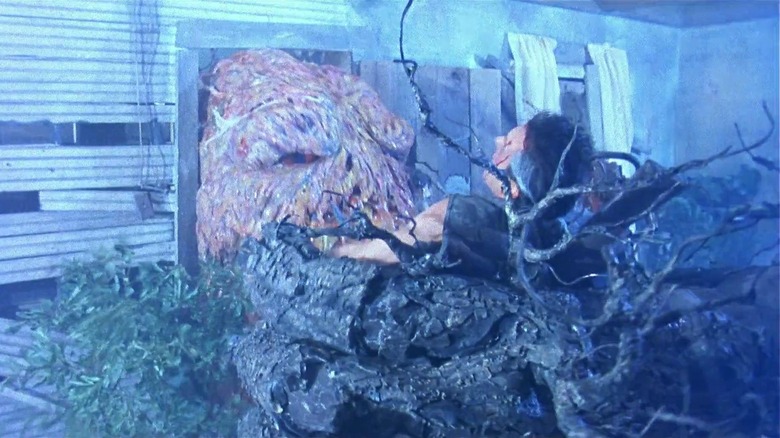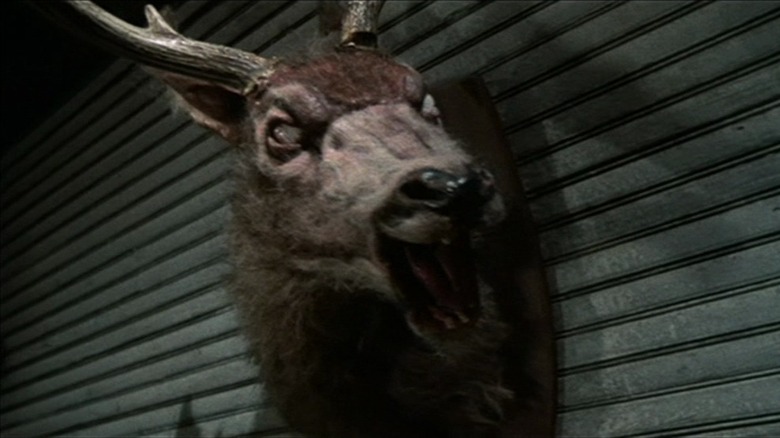The Untold Truth Of Evil Dead II
Long before he turned a Marvel hero into a zombie in "Doctor Strange in the Multiverse of Madness," director Sam Raimi proved he was the master of the undead subgenre in his "Evil Dead" trilogy. Even more impressive, he proved he could handle any sub-subgenre within it: starting with brutally straight-ahead horror in "Evil Dead," he injected a heavy dose of comedy in "Evil Dead II" and went all in on the genre-busting slapstick swashbuckler "Army of Darkness." Fans have never been able to agree which is the best, but we've always had a soft spot for the middle chapter, funnier than the original but less goofy than "Army of Darkness."
Best of all, it's a true horror comedy, always keeping you guessing whether the next moment will make you laugh or scream. And sometimes, even more disturbingly, it'll switch back and forth in a single scene, like the classic "laughing house" sequence, where all kinds of inanimate objects come to life like a "Silly Symphony" cartoon and start laughing at Final Boy and sort-of hero Ash (Bruce Campbell). He starts laughing along until his laughter turns into a scream of abject terror. Even the lamp's goofy Popeye laugh turns into a bloodcurdling wheeze.
So how did this masterpiece of splatstick enter, much like the Evil Dead themselves, into our universe? Well, there was a lot of blood, sweat, and tears (mostly sweat) involved, but everyone seemed to have a ball anyway. Here are their stories.
The crew set up a studio in a middle school
Striking a deal with Dino DeLaurentiis, the Italian superproducer behind everything from art-film masterpieces like "Nights of Cabiria" to proudly campy blockbusters like "Barbarella" and "Flash Gordon," Sam Raimi was able to command a budget 10 times higher than the $375,000 he spent on the original "Evil Dead."
But "Evil Dead II" was still very much a B-movie, and Raimi and crew had to get creative to keep costs down. For instance, they didn't operate from a glamorous high-rise in sunny Burbank, California. According to the Hollywood Reporter, the best they could get was an abandoned middle school in the small town of Wadesboro, North Carolina. "The library was the production office," Bruce Campbell explained. "We reopened the cafeteria. The dailies were shown in the auditorium. Every department had a classroom."
Even that low-rent setup was only made possible by greasing a lot of palms. Campbell continued, "I had to go to the school board to get permission to use the school. By the time I was done, I had given something to every school board member: 'You're a contractor, you can build the access door we need for the trucks.' 'Sure, you can put in the alarm system.'" It may not have had an ocean view (or air conditioning), but it did the job.
The cast had to learn to act in reverse
It's rare that you can describe a movie as both a shoestring production and a special effects spectacular, but that's exactly what "Evil Dead II" is. Raimi accomplished this by combining every trick in the book — prosthetic makeup, simple hand puppets, high-tech animatronics, stop-motion animation, miniature sets, matte paintings, overcranking, and undercranking.
Most cost-effective of all, he simply ran the film backwards. Some scenes are obvious, like the smoke receding into the ground as the sun rises after Ash's first night in the cabin. But others are so seamless that it would probably never occur to you there were any special effects involved.
For instance, the documentary "Swallowed Souls" reveals that the scene of Bobbie Joe swallowing Henrietta's popped-out eyeball was filmed by yanking the eyeball out of her mouth. To get attacked by the trees, she sat on a grass-covered treadmill, and the roots growing into her face were actually attached before being pulled out. Raimi leaned so much on his backwards trick that Bruce Campbell recalls on the Blu-ray audio commentary, "I remember watching the dailies and Sam turned to me, going, 'That is the worst reverse-motion acting I've ever seen.' You'd only hear that from Sam."
Bruce Campbell borrowed the tape recorder from his dad
"Evil Dead II" is in a strange position as a pseudo-sequel. Despite the number in its title, it's more of a remake. More accurately, it's an expansion, cutting the original cast of cabin guests to two and getting to the original ending with Ash as the lone survivor almost as soon as it's started so the movie can move in new, wackier directions. This caused no small confusion — Campbell likes to joke that people ask him how Ash could be stupid enough to go to the same cabin and summon the same demons twice.
According to the commentary, you can blame the discrepancies on New Line, who denied Raimi the rights to his own footage, scuttling plans to open with a recap and forcing him to film it all over again. Even the set had to be recreated from photos, leading to some oddities like mismatched paneling in the living room.
But at least one prop was consistent across the series: the tape recorder that summons the Deadites. That's because it wasn't a prop — it's hard to imagine the first "Evil Dead" had room for a trip to Radio Shack in the budget — but a loaner from Campbell's dad. That wasn't even the first time he borrowed it: it's also the same recorder Raimi and Campbell used to create soundtracks for their early experiments with the silent Super 8 camera.
Bruce Campbell only used his stunt double twice
If there's one thing Sam Raimi loves more than making movies, it's tormenting his friends — and if he can combine those two pleasures, all the better. Just look at Raimi's "Oz the Great Powerful" and "Doctor Strange in the Multiverse of Madness," where he gives Campbell a cameo just long enough for him to get beaten up and leave, or "The Quick and the Dead," where he made up an excuse for actor Pat Hingle to wallop on Campbell when the cameras weren't even rolling.
In theory, Campbell had a stunt double to take some of the punishment for him. In practice, as he explains on the Blu-ray commentary, he got to use him exactly twice. Raimi responds, "The more there was a chance of Bruce hurting himself, the more appealing it was to let him do his own work!" It does nothing to shake Raimi's prankster image a few minutes later, when the crew is shown watching Ash get whacked by a branch and Campbell remembers that Raimi was holding it from offscreen.
But Campbell got off easy compared to Sam's little brother Ted Raimi, who, as little brothers tend to, got the worst of it. He wore the 20-pound hag suit in the blazing Southern heat, sometimes spun around on a harness, and was always sweating — in the scene where Henrietta flies round yanking archaeologist Annie by the hair, you can actually see sweat pouring out of her ear!
Jake almost died filming his death scene
As with any low-budget movie, let alone one directed by a sadistic prankster, risk of injury was ever-present on the set. In "Swallowed Souls," the actor who plays Ed, Richard Domeier, recalls signing a contract waiving responsibility for every imaginable injury.
Fittingly, the closest any actor got to actually kicking off was while filming his character's death scene. When Henrietta drags Jake down into the cellar, actor Dan Hicks had a brush with mortality, not via zombies, but by the high-pressure, high-volume spray of blood that accompanied his demise.
Hicks estimates that volume at 55 gallons within three and half seconds. On the first take, the hose was misaligned so that instead of spraying out of the cellar, it sprayed straight up at the cellar door and dropped down again right on top of Hicks. "I almost choked to death," he says — but showing the scrappy spirit it took to survive the production, he adds, "And then, of course, I went in and did it again."
Ash flying was filmed last in case Campbell got hurt
Some stunts were so risky that Sam Raimi had to take extra insurance on them. Specifically, there's the scene where the invisible evil force grabs Ash and sends him flying through the air, spinning upside-down and back again, ramming straight into every obstacle in his path.
Even though this happens in the first 10 minutes of the movie, the commentary reveals it was the last scene Raimi filmed. Why? Well, that really is Bruce Campbell there, and he really is slamming through every tree in the forest. As he explains on the commentary, they waited until the rest of the movie was done, "that way in case anything happened to me, we'd be fine." Given how much other abuse Campbell takes throughout the movie, that's really saying something. But it turns out the crew had every right to be worried: just before Ash goes flying, the cameraman simulates the Evil's point of view by driving a motorcycle with a camera attached through the cabin, before stopping right in front of Campbell's face and breaking his jaw.
You can see over the top of the set in one scene
Most movie and TV sets only include what you see on camera, both to save money and have someplace to keep the lighting and sound equipment. The classic example of illustrating this is probably "The Fresh Prince of Bel-Air," where Will Smith asks, "We so rich...why we can't afford no ceiling?" as the camera tilts up to show the stage lights above his head.
As you'd expect for a movie that probably cost about as much as a single episode of "Fresh Prince," the "Evil Dead II" cabin also couldn't afford a ceiling. If you don't believe us, just skip ahead to 13 minutes in, when the evil presence chases Ash through the house. The scene is so fast-paced that it's easy to see why no one bothered to redo it, but if you keep your finger on the slow-motion button, you'll be able to spot a corner of the unpainted lumber scaffolding that hangs over one room, and what looks like a camera rig behind another. Finally, when Ash gets back to the entryway, you can see clear through the nonexistent ceiling to the outside, where a couple of light rigs are "hidden."
Raimi's school dance teacher modeled for the corpse dance
One of the most disturbing scenes in "Evil Dead II" — and one we nominated for most disturbing scene of all time — begins when the Evil's first victim, Ash's girlfriend Linda, turns out to be less dead than he hoped. Her headless body rises from the grave and starts dancing, eventually rejoining with her eerily doll-like head. Doug Beswick animated the scene in stop-motion, and as anyone who's grown up getting the creeps from "The Nightmare Before Christmas" or "The Corpse Bride" can tell you, the process creates an uncanny valley effect that Beswick plays to the hilt. The result is creepy, beautiful, and kind of silly all at once.
A clay figure might have done all the dancing, but Beswick was still drawing from life — and from an unexpected source. Sam Raimi reveals on his commentary that he got in touch with his old high school drama teacher, Helen LaBatte, to choreograph Linda's undeath dance. Effects supervisor Greg Nicotero adds that she even acted it out herself (presumably except for the parts where Linda's head falls off). It's hard for most of us to imagine our teachers approving of an adult career making trashy horror movies. It's even harder to imagine them being so supportive that they'd actually help make your trashy horror movie.
Evil Dead II includes a Krueger cameo
For a low-budget film set, the cabin in "Evil Dead II" is remarkably packed with lived-in detail. There's even enough clutter around to hide some clever Easter eggs, like the blade-fingered Freddy Krueger glove hanging in the work shed.
No, Raimi wasn't teasing a crossover. That glove is part of a good-natured feud with Wes Craven that goes all the way back to the beginning of Raimi's career, and almost to the beginning of Craven's.
In Craven's third movie, "The Hills Have Eyes," the hillbilly cannibals tear through a "Jaws" poster. Raimi says on the commentary that he interpreted that scene as Craven saying these were real monsters, not Hollywood phonies. So he returned the favor with a torn-up "Hills Have Eyes" poster in the first "Evil Dead," as he told Esquire, "to tell Wes, 'No, this is the real horror, pal.'" But Craven could dish it out as well as he could take it, and in "A Nightmare on Elm Street," he showed one of Freddy's victims falling asleep to "Evil Dead" on TV.
Raimi says that for all the sniping, the two hit it off well when they finally met at Cannes, where naturally Raimi pranked Craven: "I hid and leaped out with a terrific shout, and he just jumped out of his skin. Then I introduced myself. He gave me a look like, are you out of your mind? He's been very kind to me ever since."
The evil hand originated in a commercial parody
When it's time to list the great icons of horror — Dracula, Frankenstein, Norman Bates, Leatherface, Jaws — hopefully there's room for Ash's chattering, possessed hand (we call him Squeaky). He might have never come to life if screenwriter Scott Spiegel hadn't messed around with the Hamburger Helper mascot. In "Attack of the Helping Hand," Spiegel enlisted Sam Raimi and Bruce Campbell for camera duties and gave Raimi a bit part as the milkman. The story: Instead of helping a housewife make hamburgers, the living glove attacks her. Just about everything from that short made it into "Evil Dead II," but fortunately without the overtone of sexual violence. Just a few examples: the hand flips the protagonist the bird in both movies. Both protagonists try to get rid of the disembodied hand by drowning it and trapping it under a bucket (they even use the same line, "Welcome to your new home") that we see sliding around in the background just when it seems like the threat is over.
Getting to revisit the evil severed hand was what sold Spiegel on the movie. As he explains in "Swallowed Souls," "Sam goes, I'm going to take that short, and it's gonna be 'Attack of the Helping Hand' meets 'Evil Dead.' And I go, 'I totally get the movie you're making. Okay, cool.'" That turned out be an understatement: The hysterical scene of Ash fighting his own hand goes past cool and into awesome territory.
The chainsaw arm was powered by cigarette smoke
The "Evil Dead" series is endlessly quotable, but few scenes have had the staying power of the montage of Ash rigging up a contraption to replace his severed hand with a chainsaw. The music swells, there's a dramatic zoom on Ash's face and of all things, he says, "Groovy."
But having to act with a chainsaw on your hand was far from groovy, baby. After all, Campbell didn't actually lose his hand (no actor wants to go that Method), so the crew had to rig up a prop chainsaw he could wear over it. Weight wasn't a problem since the propmakers stripped out all the operating parts.
But that caused a whole new problem. Even though all the parts were gone, the chainsaw still had to smoke like it was working. Campbell says (via The Hollywood Reporter), "They figured out that the best thing — for all this smoke to travel like we wanted it to through the tube — was actually tobacco smoke. I was basically getting second-hand smoke all day long." The tube through which the smoke poured ran down Campbell's arm and leg and out behind him: "When they were done at the end of the day they pulled the tube out and my whole body had about an inch-wide stain from all the tobacco smoke." Compared to most of what he went through on "Evil Dead II," this must have seemed like a walk in the park.
A local haunted house snatched up one of the monsters
If there's a simple explanation for the enduring success of "Evil Dead II," it's that, as effects artist Shannon Shea says in "Swallowed Souls," it captures better than any other movie the thrills of a carnival House of Horrors. Sometimes you'll get a good laugh out of the cheesiness of it all, and sometimes some horrible creature will jump out of nowhere and scare you senseless. Stroll across the boardwalk to the roller coaster, imagine taking both rides at once, and you'll have a good sense of what makes "Evil Dead II" so special.
Someone seems to have taken the funhouse connection a little too literally, because that's where one of the props ended up. To defeat the Evil, Annie has to recover, translate, and recite a spell to "make it a thing of the flesh" so Ash can kill it and/or send it back in time. The Evil's corporeal form appears as a gigantic animatronic that the crew nicknamed "Rotten Apple Head." On the commentary, Raimi explains that the crew lost track of it. It was too heavy for them to haul off the set, but some local businessman apparently thought it was worth the weight. Raimi knows this because that October, the Rotten Apple Head resurfaced at a local haunted house.
Sam Raimi didn't like the sight of blood
Even when the shoot was over, the production of "Evil Dead II" still had some shenanigans to pull. In "Swallowed Souls," editor Kaye Davis tells how she started cutting the film in Michigan, far away from the producers, so Sam Raimi could make his own vision clear before any of his backers stepped in to ruin it. In one test screening, she got her hand stuck in the projector and bled all over the film. That's already the kind of story you'd tell everyone you know for years, but the real kicker was Raimi's reaction. While everyone else, Davis included, was laughing at the gruesome turn of events, Davis recalls, "I turn around, and Sam looks like he's gonna toss it ... he said, 'you know, the sight of the blood really bothers me.'"
This is Sam Raimi we're talking about, who — in case you've forgotten — hosed down both Bruce Campbell and Dan Hicks with gallons and gallons of high-pressure blood. How someone gets such a kick out of splattering fake blood every which way could react so negatively to the real thing is likely to remain a mystery for the ages.
